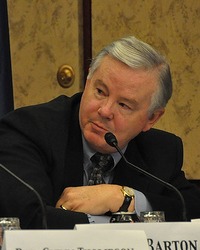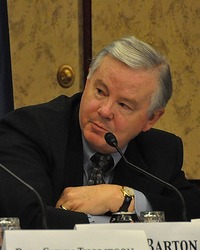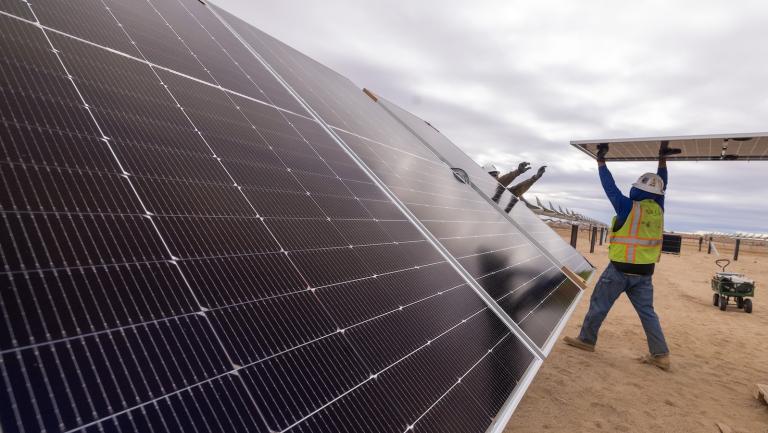 Rep. Joe Barton (R-Texas) is behind the bill.
Rep. Joe Barton (R-Texas) is behind the bill.
Cross-posted from Climate Progress.
In a move that could be called anything but conservative, Republican lawmakers are set to bring a bill to the House floor next week that will repeal state and municipal rights to set efficiency standards for lightbulbs. The bill would unravel a piece of federal legislation that was strongly supported by lightbulb manufacturers and has spurred innovation in the lighting industry.
The bill, sponsored by Texas Republican Joe Barton, would strip away any “federal, state or local requirement or standard regarding energy efficient lighting” that uses lightbulbs containing mercury. In other words, all compact fluorescent bulbs.
Remember, in May, Barton denied there was any “medical negative” from mercury emitted from coal power plants. Now he fancies himself a protector of the public from a vastly smaller source of potential mercury poisoning. The reality: There is an extremely small amount of mercury in CFL bulbs. Even after more than eight hours of exposure, mercury levels are equal [PDF] to eating a six ounce can of tuna,
But that’s not what this is really about.
Barton’s bill targets the Energy Independence and Security Act (EISA) of 2007, which increases the efficiency of incandescent lightbulbs by 27 percent through 2014. It was a completely noncontroversial bill that had bipartisan support, was strongly supported by lightbulb manufacturers (and still is), and was signed into law by George W. Bush.
“When this bill was passed, it was passed by people who knew how to make lightbulbs,” says Randall Moorhead, vice president of government affairs at Philips, a leading lightbulb producer. “Everyone supported it. And since then, it’s created more choice for consumers — we have two incandescent bulbs on the market that weren’t there before.”
But in an effort to score political points in the 2012 election cycle, Republican lawmakers have made patently false statements about the law, calling it a ban on incandescent lightbulbs. Michigan Republican Fred Upton, who supported the law in 2007, is now backpedaling and claiming that the efficiency standard is an example of “federal overreach.”
Upton, who has been serving in Congress since the mid-1980s, surely understands that minimum efficiency and safety standards for lighting and appliances have been a part of the industry for decades — no one would make the preposterous claim that the government has come in and made them change their microwave, refrigerator, or dishwasher.
“We support the notion that efficiency is a desirable thing, and this type of standard has been a part of our body politic for a long time,” says Moorhead of Philips. “The reality is, consumers will see no difference at all. The only difference they’ll see is lower energy bills because we’re creating more efficient incandescent bulbs.”
Moorhead explains the business case for the efficiency standard to Climate Progress:
The 2007 law set minimum efficiency level. That’s it. Everyone in the industry knew that it was set at a point that we could still make incandescent lightbulbs. The industry never would have supported a law that would have banned a technology or prevented us from making a light with a certain kind of ambiance.
The reality is, the new incandescent lights were not being made because there was not an economic incentive to make them. And now Philips [and other manufacturers] makes two types that were not made before EISA. Today, under the efficiency standard, consumers have more choices, not less. They still can choose from more types of incandescent lightbulbs that will be more efficient.
It’s not just Philips making these bulbs. GE and Sylvania are also producing new, energy-efficient incandescents using the same technology. And by 2014, consumers will not be forced to buy more expensive LEDs or moderately priced CFLs — they’ll be able to buy incandescent bulbs that today cost $1.42 and use 27 percent less energy.
If just a third of the 4.4 billion medium screw-based light sockets around the country were replaced with new, efficient incandescent light bulbs, one third with compact fluorescents, and one third with LED bulbs, the annual savings could be more than $12 billion a year, says Moorhead.
“The economics work out extremely well for the consumer,” he explains.
The American Council on an Energy Efficient Economy says that the standards would eliminate the need [PDF] to develop 30 new power plants — or about the electrical demand of Pennsylvania and Tennessee combined.
The 2007 efficiency standards weren’t just about saving energy — they were also about providing manufacturers with a consistent marketplace. With numerous states passing minimum standards for lighting, companies were looking at the prospects of having to produce different bulbs for different states. When the law was passed in 2007, it created a national marketplace that was deemed good for business, says Jeffrey Harris, the senior vice president for programs at the Alliance to Save Energy.
“Repealing this standard would undercut manufacturers’ confidence,” Harris says. “This has been all about creating market certainty that would encourage more innovation — and it’s worked. Why would we want to take that away?”
The bill is expected to come to the floor early next week. There’s some speculation that the bill will be introduced under “suspension of the rules,” which would limit debate and not allow any amendments — but also require a two-thirds vote to pass.
Numerous consumer advocacy groups, businesses, and environmental groups are pushing hard to educate lawmakers about the immense benefits of the standards. But in today’s politically charged environment, common sense isn’t exactly a virtue.
“It’s a nice bumper sticker statement to claim that the government is going to come in and take your lightbulbs away. Unfortunately, my five-page white paper that explains the effectiveness of the law has a hard time competing with that,” says Moorhead.
A new analysis from the Natural Resources Defense Council shows that repealing the standard would ultimately cost the country more than $12.5 billion annually. The lightbulb standard will reduce Americans’ energy costs by about $85 per household every year when the standards are fully in place. More efficient light bulbs also will eliminate the need for 33 large power plants — and the pollution they generate.




